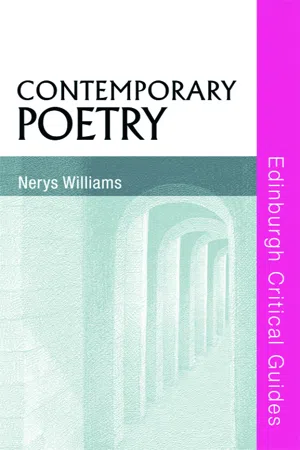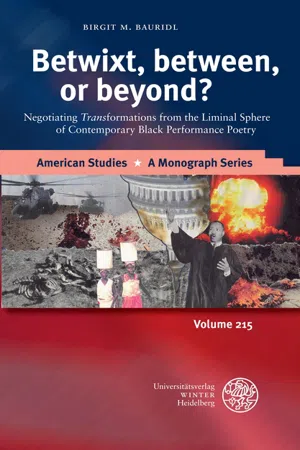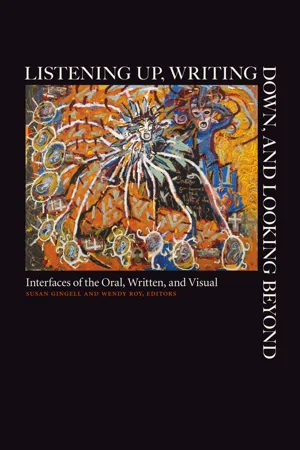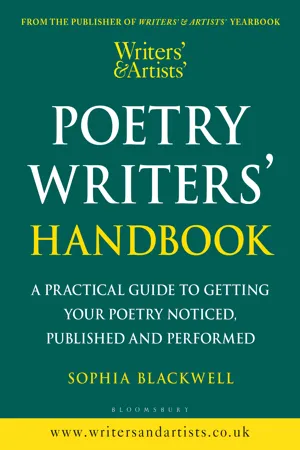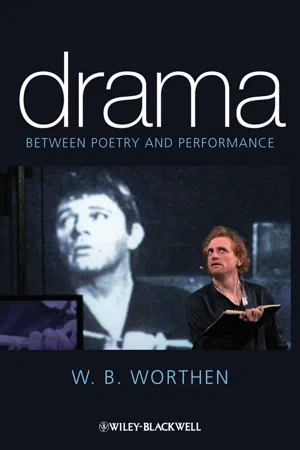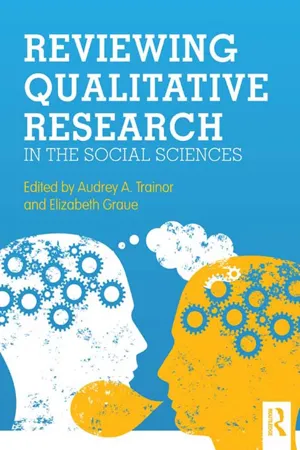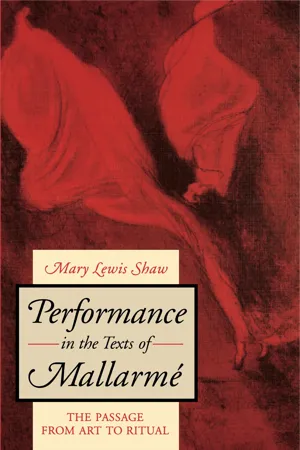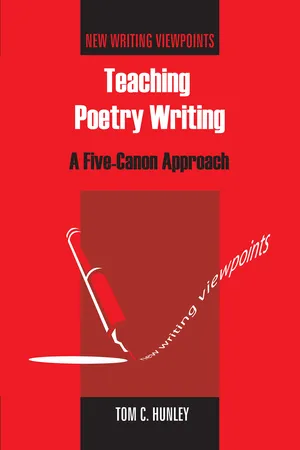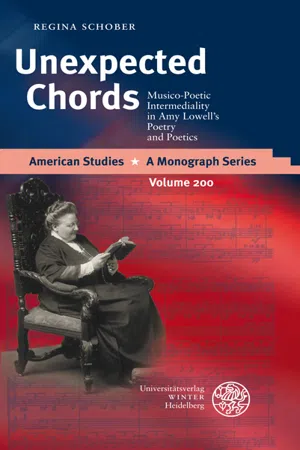Literature
Performance Poetry
Performance poetry is a form of poetry that is written to be performed aloud, often with elements of rhythm, music, and theatricality. It emphasizes the oral and aural aspects of poetry, engaging the audience through the use of voice, gesture, and emotion. Performance poets often use their work to address social and political issues, and their performances can be powerful and impactful.
Written by Perlego with AI-assistance
Related key terms
1 of 5
10 Key excerpts on "Performance Poetry"
- eBook - PDF
- Nerys Williams(Author)
- 2011(Publication Date)
- EUP(Publisher)
chapter 3 Performance and the Poem T he term ‘Performance Poetry’ is now commonly used to describe a presentation that may never be transcribed into volume or a book. ‘Performance’ in this context indicates the inter-action of poetry with its audience; the event may often be ephem-eral and experiential, such as a slam poem or improvised talk. The focus of this chapter is to consider how contemporary poetry may ‘perform’ in a plurality of senses. Drawing from poetic manifestos, we can consider the poetry performance as a form of musical-ity: poetry, as Charles Olson suggested, becomes a score for the voice. Focusing on poets associated with cultural movements and protest writing, poetry can also perform the demands of appeal-ing to an audience and inciting change. Performance Poetry in this light allows for textures of call and response, humour, parody and polyphony. While performance may emphasise a dramatic component, in considering textual performance contemporary poetry also ‘performs’ visually on the page – through experimental typography. I consider the various ways that poetry may perform or can be considered in Judith Butler’s formulation ‘performative’. Approaching performance as the sonic or textual iteration of rhe-torical gestures and personas enables a more nuanced considera-tion of how identities are performed as processes of mobility and change. Increasingly in both critical and poetic circles there has been attention to ‘performance writing’ that places its focus upon an investigation of the performance of language in different fields. NOT FOR DISTRIBUTION OR RESALE. FOR PERSONAL USE ONLY. performance and the poem 99 OPEN FIELD POETICS AND PROJECTIVE VERSE: ADAPTATIONS Published in 1950 , Charles Olson’s groundbreaking manifesto essay ‘Projective Verse’ presents an important envisioning of the relationship between poetry and performance. 1 Olson describes projective verse as a form of open poetry. - No longer available |Learn more
Betwixt, between, or beyond?
Negotiating 'Trans' formations from the Liminal Sphere of Contemporary Black Performance Poetry
- Birgit M. Bauridl(Author)
- 2013(Publication Date)
- Universitätsverlag Winter(Publisher)
Fine-Tuning the Concept 97 and topical. Performance Poetry is characterized by an ambiguity that, upon its first encounter, may appear as a dichotomy: Performance Poetry is, on the one hand, personal while, on the other hand, it debates, aspires to impact, and communicates with cultural, political, and social issues. 88 Yet this needs not be a contradiction. Since poetry slams and perfor-mances attract many performers who themselves are exposed to issues of ‘race,’ ethnicity, gender, sexuality, class, and their myriad intersec-tions, exactly these issues, which are both personal and collective, oftentimes become “central subjects” (Wheeler 151; see also Carlson, Performance 177; see also Evans, interview). “[M]arginalized identi-ties” thus turn into an important concern in Performance Poetry (Somers-Willett, Cultural Politics 7). In a wider sense, Performance Poetry addresses larger questions and problems of a local or translocal sphere in which the poets themselves move. Poems display “social pro-test” and “anti-war feeling[s]”; they attack “consumerism,” “sexism,” “drugs for their destructive force,” and “racism” (Wheeler 149). You will also “hear,” as performance icon Algarín underlines, of the War in the Gulf, the Los Angeles riots, natural disasters of all types, and serial killers. […] [A]nd you will hear poems on rape, whether it be the reporting of a rape, or the autobiographical revelation of the experience. Oftentimes it seems as if the mid of New York is on display, and that the mind of the poet and the city are one in their con-cerns. (“Sidewalk of High Art” 26-27) The idea of outreach (beyond the limits of the poem) into ‘the real 88 The poems that tend to get the highest scores in slams are often exactly those that deal with both personal and socio-political matters (see Beach 131; Wheeler 148). See also Wheeler who statistically observed the 2005 nationals and comes to the conclusion that “the majority of the poems […] were framed as personal. - eBook - PDF
Listening Up, Writing Down, and Looking Beyond
Interfaces of the Oral, Written, and Visual
- Susan Gingell, Wendy Roy, Susan Gingell, Wendy Roy(Authors)
- 2012(Publication Date)
- Wilfrid Laurier University Press(Publisher)
In the case of poetry, oral performances like poetry slam make the sociality of poetry clearly visible, allowing for the close observation and exploration of social contexts and artistic collaborators. I would contend, however, that the distinction between written and oral poetry is less distinct than is often assumed. 1 Both are inherently collaborative, communicative performances mediated by the specific social contexts of their production and consumption, so that “the difference between performance and non-per-formance poetry is more a matter of degree than strictly of kind” (Baugh 41). As McKenzie (4) argues, there is much to be gained by exploring the congru-ence between these textual forms. The current essay develops this argument, using data drawn from an ethnographic study of poetry slam based in the United Kingdom and the United States of America. Slam provides the perfect departure point from which to explore the similarities, differences, and relationships between performances on the page and stage since slam is typically located firmly at the stage end of this putative dichotomy. Both this positioning and the dichotomy itself are central to the way in which slam is defined by its critics and advocates alike. In this context, 78 Listening Up: Performance Poetics written poetry can be seen as representing the dominant literary world while slam is equated with Performance Poetry more generally. As this essay seeks to demonstrate, however, written poetry is no more absent from slam than performance and orality are absent from the printed text. Rather, a close analysis of the slam world supplies many examples of interactions between page and stage, between Performance Poetry and the poetry valued by the academy. The Oral and the Written Poetry is a diverse art, widespread in both form and application. Many of our daily activities and significant life events are played out to a poetic accom-paniment. - eBook - ePub
Poetry Writers' Handbook
A Practical Guide to Getting Your Poetry Noticed, Published and Performed
- Sophia Blackwell(Author)
- 2022(Publication Date)
- Bloomsbury Yearbooks(Publisher)
Whether or not you print or publish it, a performance poem has some sort of life on the page, even if only as a series of notes during the poem’s composition. Very few performance poets assemble poems completely orally, line by line until they are committed to memory (this approach harks back to the improvised or semi-improvised style of the Beat poets) but some of us tend to create parts of the poem, particularly the choruses, in this way. Unless the poem’s composer has a fiercely good memory, some of these elements of the performance poem would have hit the page at some point, in a notebook or scribbled on a bus ticket or cigarette packet or typed into the Notes app on a mobile phone. Given that all poetry arises from an oral tradition, there is no such thing as a pure page poem, but there’s no denying that some poems work better on the stage than others. Your poem may be a performance poem if it includes:- A joke and a punchline, or several of them.
- A strong, driving rhyme scheme or rhythmic structure.
- A contemporary or political theme.
- A narrative or a story (boy meets girl, relationship goes sour, or the story of someone growing up).
- One or two repeated choruses or hooks, like a song, or any other musical quality.
- An element that encourages the audience to interact with it, such as call and response.
- A central subject that is accessible and universal, or personal and visceral – relationships, families, death, loss, embarrassing situations.
- A parody of a well-known poem or song.
- A satire on a familiar political figure or something most people dislike.
- An exploration of identity or culture that your audience may not be familiar with, particularly if that culture is your own.
- Short, unpretentious words and recognisable images and references.
- A quality that means you can feel the poem in your body when performing it.
Being inspired by attending a poetry night is an important first step on your journey as a performer, but try not to write a first performance poem from scratch because you think it’s what the audience in that venue want to hear. Instead, look at the poems you already have before making your debut, and see if any of them have entertaining, humorous or personal elements and if these can be extended, exaggerated or teased out. Performance poems don’t have to be lewd, crude and barnstorming – quiet ones are often just as acceptable and can be a relief for the audience after a night of shouting. Chosen judiciously, a quiet piece may sway the audience in your favour and act as a signal of your confidence in your abilities if you can land the poem without having to raise your voice. - eBook - ePub
The Princeton Encyclopedia of Poetry and Poetics
Fourth Edition
- Stephen Cushman, Clare Cavanagh, Jahan Ramazani, Paul Rouzer, Stephen Cushman, Clare Cavanagh, Jahan Ramazani, Paul Rouzer(Authors)
- 2012(Publication Date)
- Princeton University Press(Publisher)
Politically motivated poetry readings early in the 20th c. served as models for others to come in the second half of the century. In postrevolutionary Russia, Vladimir Mayakovsky sang the praises of the October Revolution in lyrics written to be read aloud; his dramatic performances attracted mass audiences both in western Europe and the U.S. Avant-garde movements of the 1920s and 1930s such as *Dada and *surrealism generated performances of poetry staged simultaneously with music, dance, and film, and so anticipated the intermedia performances later in the century. *Poetry readings of the 1950s and 1960s often took the form of multimedia presentations and random artistic “happenings.” Prominent innovators of the poetry performance in the 1950s were the *Beat poets, notably Allen Ginsberg, Gregory Corso, and Lawrence Ferlinghetti, all instrumental figures in the movement now known as the *San Francisco Renaissance. Orality and performance were foregrounded in the poetics of Charles Olson, who conceived of the poem as a “field of action” and made his unit of measure the “breath group.” Olson’s *“projective verse” found followers in Robert Duncan, Robert Creeley, and Denise Levertov. Af. Caribbean dub poetry, a form that originated in Jamaica in the 1970s where poetry is spoken over reggae rhythms, has been important to a range of diasporic artists, like Linton Kwesi Johnson, who intervene in an evolving cultural politics through performance.Since 1960, New York, Chicago, and San Francisco have been the major Am. poetry performance centers, with London, Amsterdam, and West Berlin their Eur. counterparts. In New York, the poetry-reading movement of the 1960s generally associated with the name of Paul Blackburn served as a stimulus for a new vogue of poetry readings in other parts of the country, esp. in Chicago and on the West Coast. Further experimentation with elements of recitation, music, song, digitized or synthesized sound, drama, mime, dance, and video, which are mixed, merged, altered, choreographed, or improvised in seriatim, simultaneous, random, or collage order, characterized the phenomena variously called *sound poetry, multimedia, or sometimes “performance art” of the 1970s and 1980s. David Antin called his improvisations “talk poems.” Jerome Rothenberg’s interest in tribal poetry led to his reconstruction in print of sound poetry along with notation of the ritual contexts that surround it. The anthropologist Dell Hymes, with Rothenberg a proponent of *ethnopoetics, devised a method of transcribing and analyzing folklore and oral narrative that pays attention to poetic structures within speech.Since the 1950s, then, the performance of poetry in America has undergone a resurgence, becoming a standard element in the practice of poetry in the Eng.-speaking world. Its tone ranges from conversational idioms to street lang. Jazz or rock music, electronic audio and visual effects, and spontaneous dramatic presentations sometimes accompany recitation, esp. outside of universities, where, it has been argued, an aesthetic narrowness prevails (Lazer). The ethos in intermedia events such as these is one of experimentation, liberation, and spontaneity. Like other contemp. literary genres, postmod. poetry maintains a strong interest in performance as a reaction to academic interpretation and its fixation on the text. - eBook - PDF
Drama
Between Poetry and Performance
- W. B. Worthen(Author)
- 2010(Publication Date)
- Wiley-Blackwell(Publisher)
Drama: Between Poetry and Performance proposes a way to read drama, one that negotiates the dialectical tension between its identity as poetry and as performance. I take “poetry” broadly: whether in prose or verse, drama imagines a distinctive experience of language, posing new chal- lenges for using writing to create something beyond words: action. Although dramatic writing often represents a fictive world and fictive human beings acting in it, as Aristotle recognized, drama is imitation in the mode of action itself, “with all the people engaged in the mimesis actually doing things.” 2 We see the action performed (not narrated) by its agents. The agents are, however, essentially duplicitous: in the theatre, “Oedipus” emerges through the actor’s remaking of writing into something else, a performance. This performance intimately iden- tifies “Oedipus” with and through the actor. We can only see, under- stand, know – identify – Oedipus with the ways the actor’s performance uses the writing, identifies it with his own activities: a specific body and a way of inhabiting it; inflections of voice and movement; strategies for occupying the space it shares with us, its audience. Actors, the design and configuration of the theatre, audience expectations – since these and other features of producing the play are outside the text, beyond Preface: Drama, Poetry, and Performance xv its control, we cannot read plays as definitive instructions for making performance. At the same time, the practices of reading – how we decode, interpret, reconstruct aspects of dramatic language, as Aristotle might have put it, as plot, character, thought, and spectacle – are not gov- erned by the text, but by the interplay between the text and conventions and practices of reading we bring to it. - Audrey A. Trainor, Elizabeth Graue, Audrey A. Trainor, Elizabeth Graue(Authors)
- 2013(Publication Date)
- Routledge(Publisher)
14 Poetics and Performance Monica Prendergast and George Belliveau The past decade or so has led to a flourishing of poetic and performance-based qualitative research (for bibliographies on each approach, see Prendergast, 2009a, 2009b; Beck, Belliveau, Lea, & Wager, 2011). Researchers have turned to these arts-based approaches for many reasons and from varied theoretical perspectives. However, the majority of poetic and performance studies could be seen as engaging in the work of art and also in carrying out the work of social science in innovative and interdisciplinary ways. The challenges inherent to the review process of poetic or performance-based inquiries, or creative submissions in other related alternate forms, is one that has been debated in conference settings, between colleagues, and in the literature (Ackroyd & O'Toole, 2010; Faulkner, 2007, 2010; Gallagher, 2007; Piirto, 2002; Saldaña, 2003, 2005; Sullivan, 2009). In all cases, however, we believe that it is imperative for reviewers to attend to both scholarly and aesthetic aspects of the work. Reviewers less familiar with poetic or performance approaches will find this chapter useful in presenting selected key terms and qualitative touchstones that attend to the necessary vigor required of a peer-reviewed publication and the attendant aesthetic qualities present in a successful poetry-or performance-based study. As researchers who have made numerous contributions to each arts-based range of methods under discussion here—and who have also surveyed these approaches through meta-analyses—we are well placed to consider the challenges of reviewing poetic and performance research studies (see relevant citations under Belliveau and Prendergast in References). Select Terms Ethnotheater and ethnodrama are defined most often as modes of dissemination of data gathered and analyzed using traditional qualitative research tools such as action research, narrative, interviews, and field notes- eBook - PDF
Performance in the Texts of Mallarmé
The Passage from Art to Ritual
- Mary Lewis Shaw(Author)
- 1992(Publication Date)
- Penn State University Press(Publisher)
C H A P T E R O N E + Performance as Ritual To perform is to interpret or represent theatrically, as in music, dance, and drama. But to perform is also to bring a reality into being, as in a declaration of war (performative language) or in the carrying out of a ceremonial gesture (ritual) in church. Since the performing arts, per- formative language, and ritual are inextricably bound in Mallarmk's texts, it is useful to consider the broad theoretical connections among them. The performing arts, by definition, require the presence in time and space of a performer and a spectator or listener. Thus, it is the intermedi- ary presence of the performer that distinguishes them from literature, the visual and plastic arts (architecture, painting, and sculpture), and from arts conveyed through mechanical reproduction (photography, film, and sound recording). Just as the element of live performance can be sub- tracted from performing arts through their mechanical reproduction, so can any normally unperformed art be performed, as would have been the case with Mallarme's ideal Book. Indeed, in the twentieth century, tradi- tionally unperformed arts have increasingly been thus presented in the multimedia works we call performance art. The ult~mate aim of this book is to show that Mallarme's literary experiments anticipate perfor- mance art in several important ways. Mallarme was, however, a poet and not a performing artist, and his interest in performance undoubtedly arose from his theory of poetry, rather than the reverse. This theory of poetry is more than a manual of style or a set of aesthetic precepts. It is a philosophy of language with an important metaphysical dimension, which is schematically set forth in his Notes. Although these Notes are among the most problematic and least discussed of Mallarme's texts, their main points require immediate presentation, for they make Mallarme's concept of the performative aspect of language and poetry relatively clear. - eBook - ePub
Teaching Poetry Writing
A Five-Canon Approach
- Tom Hunley(Author)
- 2007(Publication Date)
- Multilingual Matters(Publisher)
Smith's co-editor June King, describes open mics in Huron, Ohio as ‘the academics, the homemakers, the erotics, the greeting-card poets, the new Jim Morrisons, the trembling first-time readers and the veteran circuit riders’ all performing an ‘egalitarian’ atmosphere of ‘inclusion’ and ‘tolerance.’ Politically correct buzz words aside, that's all very sweet, but should Performance Poetry have to abandon standards? Obviously at slams, not all poems are considered equal. Some get a ‘10’ and the poets move on to the next round; others get a ‘1’ and the poets either sit and stew or they go home. At slams, it seems, some poems are better tolerated than others, and some poets are more included than others. My guess is that even the friendly Huron crowds King describes aren't as egalitarian as she makes them out to be. I'm sure that they look for certain effects in poems and they use subtle cues ranging from cheers and raucous laughter to yawns and side conversations as rewards or sanctions for those performers who deliver and those who don't.Of course contemporary oral poetry is not just an American phenomenon. The United Kingdom also has a thriving public poetry culture. In London, The Poetry Society even operates an establishment called Poetry Café, where patrons can drink tea and eat sponge cake while enjoying an open mic or one of several regularly scheduled readings, including Exiled Writers Ink, a gathering of writers exiled from their homelands who meet to read their works to each other.The following is a slam poem written by Grace Bruenderman, one of my students who is also a member of Western Kentucky University's national champion forensics team as well as a slam poet who is currently part of Bowling Green, Kentucky's team and has competed in the nationals twice. Let's examine the ways that her poem works off the page and ways it can work better on the page, as a way to examine the sibling relationship between spoken word and page poetry. There's a common expression among members of twelve-step recovery groups: ‘take what you need and leave the rest.’ What can student poets take from spoken word artists and what should they leave? Anne Waldman defines a performance poem as ‘a poem written to be performed before an audience.’58 But how is a readership similar to and different from an audience? Answering this question is a key to answering the question of what poetry writing students can take from spoken word and what they should leave.Grace didn't write this poem in response to any of my class assignments. I wish she had; I'd like to take some credit for it. She approached me with it prior to our class reading and told me that, since she wrote the poem to be performed, she thought it would work better at the reading than the poems she wrote for class. In Grace's mind, the divide that Lansana perceives between page poetry and stage poetry is very real. ‘I don't take my slam poems too seriously,’ she told me on more than one occasion, but I think that there's a lot to admire in this piece. - No longer available |Learn more
Unexpected Chords
Musico-Poetic Intermediality in Amy Lowell´s Poetry and Poetics
- Regina Schober(Author)
- 2012(Publication Date)
- Universitätsverlag Winter(Publisher)
In contrast to improvised and/or oral poetry, the processes of composition and performance do not conflate in Lowell’s poems. For Lowell, as for many other Modernists, perfor-mance did not (yet) replace the act of written composition, but rather complemented and completed or preceded it. In her performances, Lowell applied a style of delivery that was more realistic and natural than many of her contemporaries. Based on C. S. Lewis’ distinction between ‘minstrels’ who recite in a “singsong voice” and ‘actors’ who in their expressive recitation stay close to natu-ral speech (Brogan and Fleischmann 895), Lowell can probably rather be described as the second type of poet performer, thus as being more ‘authentic’. Presumably, however, her style of delivery was not as con-versational as for instance that of Robert Frost or W. H. Auden. According to Damon, the essentials of her reading were perfect clarity, perfect intelligence, dramatic fire, and an exquisite yet unmistakable rhythm. She did not chant her poems, or read them in a monotone of painful ecstasy; her clear soprano blurred no word but varied continually according to the content. People sat up to hear, and listened with open eyes. (393) Lowell favored neither over-emphasized nor over-natural declamation. On the one hand she advised other poets to give words “the sound they have in everyday speech,” while on the other hand warning against Introduction 43 reading poetry “as if it were prose” (“Poetry as a Spoken Art” 20). “Neither extreme is necessary,” she concluded with regard to this mat-ter – and opted, as so often, for the happy medium (21). Lowell’s take on performative poetics not only affected the writing process but, as with a piece of music, poetic performance also demanded an equally skilled performer. According to Lowell, the public neglect of poetry also had to do with the lack of satisfactory performance practice.
Index pages curate the most relevant extracts from our library of academic textbooks. They’ve been created using an in-house natural language model (NLM), each adding context and meaning to key research topics.
